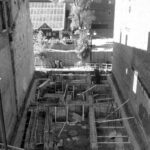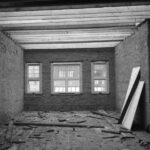
Templar Flats
- Dev Team
- 12 Dec 2016
From Teardown to Transformation
It was a 5-minute conversation followed by a 30-day closing period and a price tag that many people thought was absurd, but the deal to purchase the four storey building at the corner of King William and Hughson Streets was the genesis of one of Hamilton’s most catalytic developments. It was the fall of 2014, and Core Urban Inc., the local development firm known for their landmark redevelopments of old urban properties, had caught wind of a methadone clinic that was planned for the old building. Fresh off their redevelopment of the Empire Times next door, the Core Urban team moved swiftly to buy the building. With the possibility of a meth clinic now averted, the team needed to figure out a plan for their new property. Unfortunately, due to the limiting size and configuration
With the possibility of a meth clinic now averted, the team needed to figure out a plan for their new property. Unfortunately, due to the limiting size and configuration of the building, it offered few options for redevelopment. It was determined that a larger package of land was needed to create a project that would do justice to the beautiful pedestrian-friendly street. What happened next is a typical example of genuine Hamilton goodwill, says Steve Kulakowsy of Core Urban. The empty lot next door was owned by labour union LIUNA, known to rarely part with land assets. However, understanding the vision that Core Urban had for the property, the union graciously sold the lot for a reasonable sum. The third piece of the puzzle came together when Synergy Developments, a young development group made up of several passionate Hamiltonians, sold the former Framing Gallery building to Core Urban despite having a more lucrative offer on the table at the time. “Both LIUNA and Synergy talked about collaborating for the greater benefit of the downtown” says Kulakowsky. “They weren’t willing to sacrifice that for bigger money”.
With the land package assembled, Lintack Architects worked with Core Urban to design what would become the Templar Flats. The building on the corner was originally two 2.5 storey buildings built in 1867 of stone. Somewhere around the turn of the century, two more storeys were added using red brick. The old look of the facade made Kulakowsky think of Old Montreal, and so he took to researching and gathering design ideas from the redevelopment of similar properties. The result was a spectacular fusion of old, less old, new, and ultra-modern. While the facade of the original 1867 structure has been sandblasted and cleaned to reveal the old limestone, the building on the formerly empty lot has been clad in new, locally sourced limestone. These sections are divided by modern glass balconies, and capped with two stunning all-glass storeys that are set back from the street out of respect for the streetscape. The old Framing Gallery facade has been meticulously restored, including the intricate gable, the custom rounded windows, and the ornate window frames and mouldings. New corbels adorn all three sections of the development, contrasting with the large modern roof overhand of the middle building, where fresh cedar cladding adds warmth and vibrancy to the soaring glass walls.

The development of the Templar Flats goes far beyond its remarkable facade. It’s 25 residential units and four commercial storefronts are serviced by a state-of-the-art heating and cooling system. The building is, in fact, the first private property to be serviced by HCE Energy, a central generating station at Bay and Wilson that also services FirstOntario Centre, The Art Gallery of Hamilton, Hamilton Place, and several other major public properties. Combined with nearly soundproof triple-glazed windows, minimal HVAC venting, and the use of reclaimed and original materials, the project is equivalent to the LEED silver level of sustainable building While the completed project is a visual and technological showpiece, it’s important to note that the redevelopment was extremely involved. By the standards of many developers, both original buildings would be considered teardowns. Years of neglect, half-renovations, and simple age had left the buildings in serious disrepair. The Framing Gallery building had a seven-inch discrepancy between walls, while the corner building was out five inches. Significant structural work was required to make redeveloping the buildings viable, but Core Urban simply counted that as the cost of doing business. “We go into projects expecting that everything is broken and in need of rebuilding,” explains Kulakowsky. “Then, when we find something that isn’t completely destroyed, we consider it a bonus. You can’t take on any redevelopment projects hoping for, or expecting the best – you have to be realistic”.
When asked about the etched frieze at the top of the limestone facade of the middle section, Kulakowsky smiles and becomes a bit wistful. “You know that saying ‘They don’t build ’em like the used to’? Well, we wanted to build it even better than that. Templar Flats will be standing long after we’re gone, but we wanted passersby to be able to look up at the building, and see something beautiful that our generation built.” Such a consideration isn’t out of character for Kulakowsky or his partners, the truth is that everything Core Urban does appears to be very intentional. From the austere frieze to the careful selection of restaurant tenants that will occupy the street-level storefronts, this team seems to be committed to the long game. Instead of simply putting up a “For Rent” sign in the front windows, Kulakowsky identified specific restauranteurs that he felt would benefit the street and the growing local market for quality dining experiences. Core Urban would rather have a storefront sit vacant than have the wrong tenant giving them cheques each month. Their approach is paying off, as all of the
four restaurant units are leased, with one restaurant merging two units into the large space they’ll need for the crowds they are anticipating. Berkeley North, a west coast-style pescatarian restaurant is already open, attracting an upscale audience and no shortage of great reviews. Opening this month is The French, the hotly anticipated new restaurant by Jason Cassis of Aberdeen Tavern fame. The third restaurant is a new venture by the venerable Tortoise Group, a high-end pizza parlour called “Frat’s”.
With only a handful of residential units still available for lease, the project is in the final stages of completion. It wasn’t an easy project, notes Kulakowsky, but he points out that, as the old adage goes, nothing worth doing right ever is. These buildings could have been demolished or left vacant upstairs while the rent was paid by a meth clinic. Instead, lights glow each night on six floors, two heritage properties were given new life, and King William Street is officially becoming the city’s restaurant row. The story of Templar Flats in some ways mirrors that of Hamilton itself: rise, fall, and renewal. As Core Urban would have it, that’s the story people will remember when they look up at Templar Flats a hundred years from now.
Comments 0
There are no comments




Add comment